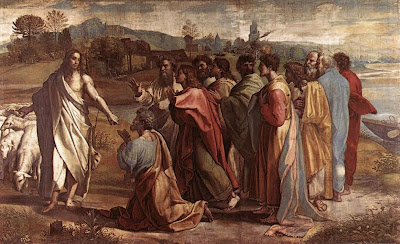 RAFFAELLO Sanzio
RAFFAELLO Sanzio(b. 1483, Urbino, d. 1520, Rome)
The Handing-over the Keys 1515
Tempera on paper, mounted on canvas, 345 x 535 cm
Victoria and Albert Museum, London
The Sistine Chapel was erected when the rebuilding of St Peter's made it necessary for other high-level ceremonies to be held in the Chapel.
On important Church feast days venerable wall-hangings were hung in the most important chapel in Christendom.
Leo X commissioned Raphael to make the drawings of new tapestries in late 1514 or early 1515. The designs were completed by late 1516.
The tapestries were woven in the tapestry workshop of tPieter van Aelst in Brussels.
One tapestry was completed by 1517, and seven tapestries were ready to be hung in the Sistine Chapel for the Christmas festivities of 1519. Three others must have arrived shortly before Leo's death in 1521.
During the Sack of Rome in 1527, these works were stolen, and were not returned until the 1550s.
Seven of the cartoons - designs drawn to scale - are in the Victoria and Albert Museum, London.
Raphael's tapestry cartoons helped to launch the "British School" of painting in the 18th century. The Raphael paintings were then the only monumental examples of High Renaissance art in England. As such, they spawned generations of painted and engraved copies,
The tapestries themselves, all woven by Pieter van Aelst, are now in the Vatican Museums. There were other tapestries made of this scene and they are in other collections:
C16th, Jan van Tiegen, Brussels for an unknown patron (Palacio Real, Madrid)
C17th, Jan Raes, Brussels for an unknown patron (Palacio Real, Madrid)
C16th, Catherine van Hinderberghe and the Master of the Geometric Mark, Brussels for Ercole Gonzaga (Palazzo Ducale, Mantua)
C17th, Jacob Geubels I, and/or his widow Catherine van den Eynde, Brussels for the Guzman family (Kunsthistorisches Museum, Vienna)
C17th, Mortlake, London for an unknown patron (Staatliche Kunstsammlung, Dresden)
C17th, Jean Lefebvre, Paris for Cardinal Mazarin (Palazzo Ducale, Urbino)
C18th, Steven de May, London for Daniel Finch, 2nd Earl of Nottingham (Cathedral Church of St John the Divine, NY)
In the cartoon, Christ appears to Peter and the rest of his disciples and gives Peter the keys of heaven. He also gestures toward a flock of sheep, telling Peter to feed them and look after them.
In the New Testament, these two scenes occur separately. Matthew 16:18-19 and John 21:15-17. (See Note 1)
In the cartoon, Raphael has combined them to make it clear that Christ is singling out Peter and to call attention to Peter's pre-eminence among the apostles.
These two biblical texts underline the justifications of the authority of the Pope.
Note the beautiful landscape in the background. At the time, elaborate, detailed landscapes were a speciality of Flemish art. Raphael's cartoons were the first Italian designs ever sent to Flanders to be woven. He was aware of the medium and the style of the Flemish tapestries. He would not have wanted to have been regarded as second rate by the Flemish artists.
Note 1
(Matthew 16:18-19)
'And I say also unto thee, That thou art Peter, and upon this rock I will build my church; and the gates of hell shall not prevail against it. And I will give unto thee the keys of the kingdom of heaven: and whatsoever thou shalt bind on earth shall be bound in heaven: and whatsoever thou shalt loose on earth shall be loosed in heaven.'
(John 21:15-17)
'So when they had dined, Jesus saith to Simon Peter, Simon, son of Jonas, lovest thou me more than these? He saith unto him, Yea, Lord; thou knowest that I love thee. He saith unto him, Feed my lambs. He saith to him again the second time, Simon, son of Jonas, lovest thou me? He saith unto him, Yea Lord; thou knowest that I love thee. He saith unto him, Feed my sheep. He saith unto him, the third time, Simon, son of Jonas, lovest thou me? Peter was grieved because he said unto him the third time, Lovest thou me? And he said unto him, Lord, thou knowest all things; thou knowest that I love thee. Jesus saith unto him, Feed my sheep.'

No comments:
Post a Comment